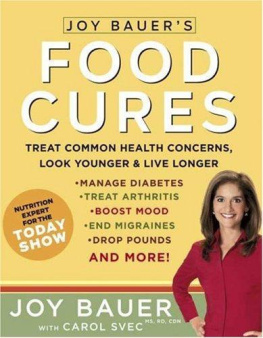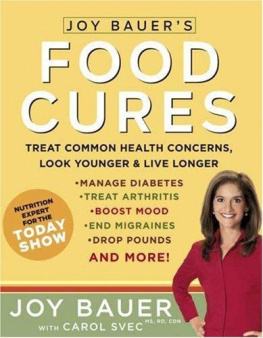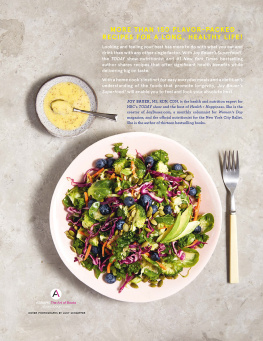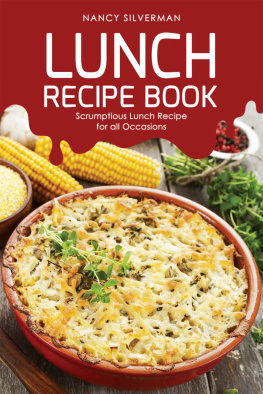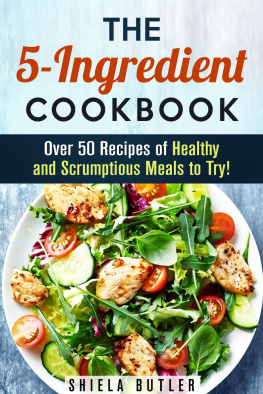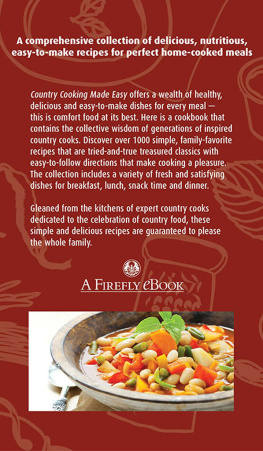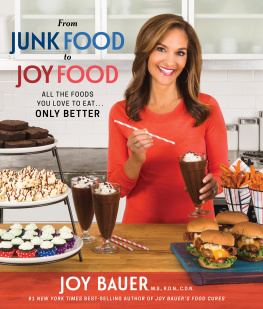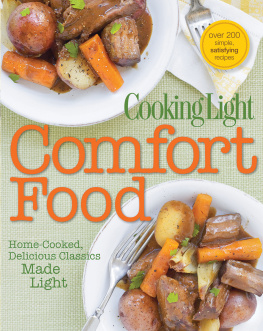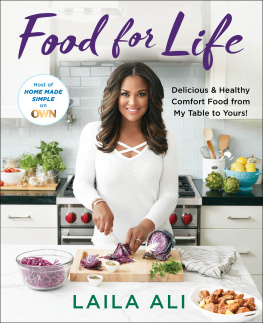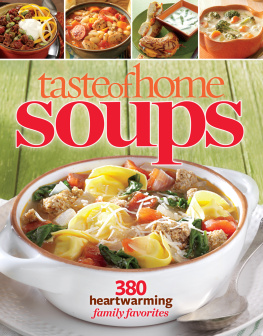To my mom, Ellen Schloss, for her grace, selflessness, and loveand for teaching me the value of a home-cooked family meal.
If only we each had our very own mealtime fairy godmother, someone with the culinary wisdom and motherly warmth of a cross between Julia Child and Mary Poppins. At 5 oclock sharp each night, the heavens would open up and shed magically swoop into the house, groceries in tow, and whip up the most smashingly delicious, 100% nutritious dinner. And of course, she would leave the kitchen sparkling clean. Sigh
Like you, I juggle way too many balls as I go from one day to the next. I have three active kids, a demanding full-time job, a wonderful husband, and scores of responsibilities that require my attention. There are plenty of days when Im in over my head and feel like Ill never find time to make dinner, and yet I nearly always do. And, day in and day out, Im glad I made the effort. Trust meyou will be, too.
Cooking healthful everyday meals for your family may herald a lifestyle change for you and the rest of your brood. Whether youre already comfortable in the kitchen but looking for more nutritious recipes to replace some of your current family favorites, or youre a culinary novice who wants to learn how to make delicious, wholesome, and foolproof meals, youve come to the right place.
Full disclosure: Im a nutritionist and a mom, not a culinary expert (and far from the next Iron Chef!). But thats good news for you, and heres why: Ive gone out of my way to ensure that the recipes in this book produce fabulous, flavorful results without requiring complicated prep or advanced technique. And while its true that cooking can be a time investment, particularly at first, the payoff is significant. Your food costs will go down, everyone will feel and look better, and mealtimes will become joyful parts of the day filled with family togetherness. And in my opinion, few things rank higher than hearing my kids compliment or special-request one of my latest creations (Please can we have Sesame Chicken Tenders for dinner tonight?). Its truecooking healthful food can be easy and gratifying.
Good News! Cooking at Home Is Better for You
You cant control what your kids select on the schools hot lunch line, the junk food they eat at their friends house, or the sugar-laden birthday cupcakes they devour in the classroomand you certainly cant stop your husband from ordering his favorite chicken parm sub and chips at the local sandwich shopbut fortunately you can control what your family eats in your own home. Here, within your own four walls, you get to call all the shots when it comes to minimizing the not-so-healthy ingredients and maximizing the healthy.
ADDED FATS, like the butter, oil, and margarine used to saut, roast, and fry food, are one of the main offenders behind high-cal meals. As a college student I held my fair share of waitressing jobs, so Ive witnessed firsthand the frightening amount of fat that goes into restaurant meals (and much of it is the artery-clogging saturated type). First theres the butter they saut the veggies in, then theres the oil they baste the meat with, then the cream and extra butter that finds its way into sauces and side dishessometimes theres even a generous drizzle of olive oil to finish off the plate. And most of the time all that extra fat is overkill. For the recipes in this book, I go out of my way to minimize all fats, even the heart-healthy oils like olive and canola. While its true that unsaturated plant oils have beneficial health effects, theyre still extremely calorie-dense, which means that liberal usage can easily add hundreds of calories to your meals over the course of a week. To make a little bit of fat go a long way, I use oil spray for sauting, roasting, and greasing pans. When you adopt this strategy instead of pouring oil directly from the bottle, youll effortlessly slash calories from your diet on a daily basis.
SALT levels in restaurant meals and convenience foods are over the top. In fact, when you are dining out, theres a good chance the entre alone contains enough salt to exceed your sodium allotment for the entire day, which is no more than 2,300 milligrams for healthy adults. Since a high-salt diet is linked to high blood pressure, an increased risk of some cancers, water retention, and bloating, its definitely in your best interest to prepare lower-sodium meals at home. Nearly all of my recipes contain less than 800 milligrams of sodium per serving, so theyre in perfect alignment with government standards for healthy entres. Unlike carbohydrates, fiber, protein, and fat, which are all measured in grams, youll notice that sodium is measured in the much smaller unit of milligramsthats why sodium numbers seem so much higher than other values on nutrition labels.
To keep sodium levels in check, I use low-sodium versions of the saltiest offenders like broth, canned tomatoes and beans, and soy sauce in my recipes. When I add salt to a dish, I season sparingly and always use kosher salt, which has a coarser grain than fine table salt and therefore yields less sodium per teaspoon. Sea salt works equally well, but be sure to purchase a coarse-grained variety. Though I realize some salt is usually necessary to make food that much more delicious, my intent is to help you retrain your palate so that it is excited by other seasonings and not controlled by the tyranny of salt.
LEAN CUTS OF MEAT are another staple ingredient in healthy cooking. When you dine out or choose prepared foods, youre at the mercy of the chefs or food manufacturers protein selections, and these guys have a big economic incentive to use cheaper, fattier cuts of meat. Think about it: how many diners make their burgers with 95% lean ground sirloin? When was the last time your fast-food breakfast sandwich came with lean turkey sausage instead of a cheap, high-fat pork patty? If you do go out of your way to order lean proteins, like lean steak, seafood, or fish, at a restaurant, expect to pay much more than it would cost for you to prepare these entres in your own kitchen. When you prepare meals at home, you can make selections that are both budget-and waistline-friendly, like skinless poultry, ground turkey and chicken, affordable fish and seafood, and lean cuts of pork and beef. Yup, you heard right, beef! If you were worried that red meat wouldnt make an appearance in a nutritionist-approved cookbook, fear no longer. I respect the fact that many of my readers love beefmy husband, Ian, is among you!so I have not neglected the category at all. In fact, the Beef and Bell Pepper Stir-Fry in Chapter 6 and the Beef Tenderloin with Fig Reduction in Chapter 6 are among Ians all-time favorite recipes. I hope youll give them a try.
LIGHT CONDIMENTS are an effective way to slash calories and fat in everyday cooking. Fortunately, most of our favorite fat-laden brands are also available in slimmed-down versions. For example, I regularly use reduced-fat mayo, sour cream, and cream cheese in my recipes. Because these dishes are already packed with delicious, fresh flavors, you wont for a second miss the extra fat. Choosing light versions of the condiments you use on a regular basis is one of the simplest ways to give your cooking a healthy facelift.
FRESH, WHOLESOME FOODS, without preservatives and other unnecessary additives and artificial colors, are flat-out good for you. Choosing foods that are not overly processed, that are in season, and that are close to their original form means you are in charge of what does and does not go into the meals your family eats. The more you cook with whole ingredients like fruits, vegetables, and grains, the more youll appreciate the clean, fresh flavors of real food .
PORTION CONTROL has become downright out of control. At restaurants, weve grown to expect gargantuan plates filled with ridiculous amounts of food, and more often than not, we wipe our plates clean regardless of whether were truly all that hungry. With this in mind, Ive suggested a healthful yet satisfying portion size for every recipe in this book. Whats more, when you follow my portion guidelines, youll often have leftovers to serve the next day, which is a smart way to trim your food budget as well as your waistline.


